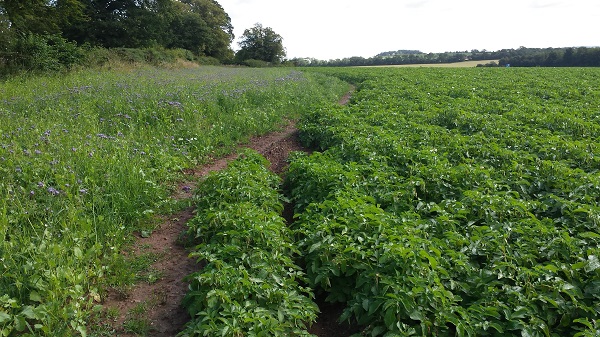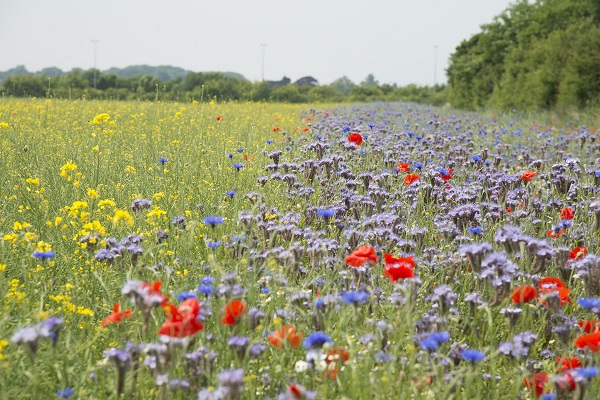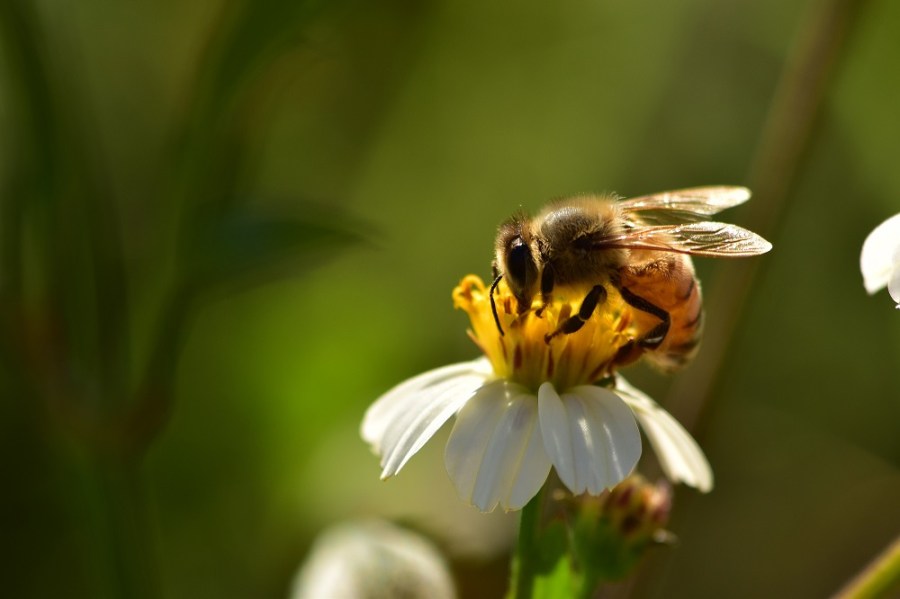Agriculture is getting bad press when it comes to bees. CPM reports on how some potato growers are managing their headlands and helping bee populations.
Public feedback on the colour and flowering of the mix was fantastic.
By Rob Jones
Establishing green cover headlands sown on potato and root vegetable crop headlands is proving a positive attraction for pollinators and helping to conserve valuable soil resources, according to results from a 2016 pilot project.
The Syngenta ‘Operation Pollinator’ initiative, instigated and supported exclusively by ASDA growers through the IPL supply chain, now aims to plant over 100ha of the specially selected Green Headland cover mix on more than 30 farms this season.

Planting a Green Headland flowering mix around the potato crop has proven to be attractive to pollinators.
Belinda Bailey, Syngenta environmental initiatives manager, points out that many potato and root vegetable headlands are typically left uncropped to aid management and harvesting of the cropped field area.
But there’s a downside to these bare soil areas; they’re left dangerously exposed to soil erosion or damage by headland-turning of heavy machinery, can become a weed burden and have little or no ecological value, she says.
“The partnership with ASDA and IPL has worked with Kings to create a specific Green Headland seed mix designed to be easily established with the crop, protect the soil structure and provide a valuable feeding and habitat resource for invertebrates and other farmland biodiversity,” she explains.
Wealth of insect life
“Monitoring of the first year’s performance has revealed the great value of the flowering mixture for a wealth of insect life, along with the positive feedback of growers on the benefits of the mixture. We’re now looking to extend its use on more farms, and to continue monitoring both the ecological enhancement and the physical improvements to soils that the Green Headland offers.”

Syngenta’s Annual Wildflower mix provides an important continuity of essential pollen and nectar when the OSR had finished flowering.
Independent ecological assessment of invertebrate biodiversity, from one visit to each of the trial Green Headland areas, revealed over 11,000 insects were collected and 140 different species. That included 41 species of pollinators; 29 species of known predators beneficial to crops and at least 118 species of potential food sources for game and other farmland bird chick rearing.
Chris Brown, ASDA senior director of sustainable sourcing, highlights the project demonstrates the good stewardship of farmland by growers supplying the company’s stores and customers.
“We invest a lot of time and effort in assuring the sustainability of food production globally; this initiative highlights the efforts of UK growers to work towards increasing biodiversity.
“These are first steps with the project, but it’s incredibly exciting and positive to see the results of independent monitoring that validates the benefits of good practice and is enhancing the farmland environment.
“It’s a genuinely sustainable initiative that can offer a simple cost-effective and time-efficient solution to make better use of an unused area of land, and in the process, improve the environment and protect the valuable soil resource.”
Adrian Baker, farm manager at F B Parrish and Son, based at Lodge Farm, Chicksands in Beds, reports one of the benefits of the cover crop used last year was its ease of establishment.
“Soil protection is vitally important on our light greensands, with measures such as a CTF (Controlled Traffic Farming) system on the fields.
“The cover crop was simply direct drilled on the headlands, and got away and grew without us spending too much time. We also noted that the green cover was effective in reducing the risk of soil erosion during potato and onion crop irrigation.”
Regionally scarce
In the first year, Adrian Baker was rewarded with 46 different species found on the farm’s four trial Green Headland areas, including the discovery of a red-tailed cuckoo bumblebee – which has been categorised as regionally scarce – along with a reed yellow-faced bumblebee, which highlighted the habitat’s value to attract a wide variety of pollinators.
“The public feedback on the colour and flowering of the mix, where a footpath crossed a cover crop field, was fantastic,” he adds.
Other notable findings for the study’s monitoring ecologist, Paul Lee, included a red-carder bumblebee, which is on the BAP Priority Species list, on a farm near Woodbridge in Suffolk, and six different species of furrow bee from just one Green Headland margin, situated alongside an onion crop in Cambs.
“Interest in soil health and green cover crops has been building momentum for the past few years,” reports Richard Barnes of Kings. “Now growers can realise the significant potential such crops can bring to wider farmland biodiversity. This work has provided a fascinating insight in to what can be achieved.”
With soil temperatures warming up quickly, now is the ideal time to also get annual wildflower seed mixtures in the ground for this season, advises Belinda Bailey.
She suggests that once oilseed rape crops are seen well into flower, it’s a good indicator that soil temperatures are suitable for sowing wildflower annuals.
“You need workable soil to create a fine seedbed, and the small seeds like to get up and away in good growing conditions.”
She points out that the fast-growing Syngenta Operation Pollinator ‘Annual Wildflower’ mix has proven especially valuable for bees and other pollinators when planted near to OSR fields, as it provides an important continuity of essential pollen and nectar when the OSR had finished flowering.
Hants farmer, Simon Butler, has found annual wildflowers have proven straightforward to establish and consistently reliable in the matrix ecological habitats created around his 550ha near Alton.
“With the annual wildflowers, we find it’s important to wait in the spring to ensure soils are sufficiently warm to encourage germination and establishment,” he advises.
“Creating a reasonably fine seedbed can help the wildflowers to establish quickly and it’s important to just sow the seed on the soil surface. Rolling it in can help conserve moisture if conditions are dry,” he says. “We always keep an eye on the weather, since heavy rain can cause the farm’s greensand soils to slump, which would be detrimental.
“We’ve seen that it’s possible to get two years out of the annual wildflowers from the natural regeneration of the mix, but it does tend to grow back with more of the dominant species and you lose some of the diversity. We would prefer to re-sow each year with a more floristically enhanced mixture to get the colour and interest, and the full benefit for the insects.”
Belinda Bailey adds that growers can start now with seedbed preparations for establishing a Bees ‘n’ Seeds mix, which would typically be sown in May or early June.
The Operation Pollinator seed mix, also available from Kings, includes species selected to provide end-of-season flowers for pollen and nectar, followed by a good supply of seeds as an overwinter feed source for game and farmland birds.




